Papers by Mark Seidenberg

Research in cognitive science and neuroscience has made enormous progress toward understanding sk... more Research in cognitive science and neuroscience has made enormous progress toward understanding skilled reading, the acquisition of reading skill, the brain bases of reading, the causes of developmental reading impairments and how such impairments can be treated. My question is: if the science is so good, why do so many people read so poorly? I mainly focus on the United States, which fares poorly on cross-national comparisons of literacy, with about 25-30% of the population exhibiting literacy skills that are low by standard metrics. I consider three possible contributing factors, all of which turn on issues concerning the relationships between written and spoken language: the fact that English has a deep alphabetic orthography; how reading is taught; and the impact of linguistic variability as manifested in the Black-White "achievement gap." I conclude that there are opportunities to increase literacy levels by making better use of what we have learned about reading and language but also institutional obstacles and understudied issues for which more evidence is badly needed. 332 SEIDENBERG of such impairments. We have computational models that specify the mechanisms that underlie basic reading skills, how children acquire them, and how differences in experience (with spoken language and reading) and individual differences (in learning and memory capacities, motivation and other factors) result in varied reading outcomes. This vast research base has led to the development of intervention and remediation methods that can reliably help many children who need it. Researchers disagree about many details-it's science, not the Ten Commandments-but there is remarkable consensus about the basic theory of how reading works and the causes of reading successes and failures (for reviews, see Rayner et al.

Journal of Memory and Language, 2002
Recent studies have suggested that age of acquisition (AoA) has an impact on skilled reading inde... more Recent studies have suggested that age of acquisition (AoA) has an impact on skilled reading independent of factors such as frequency. This result raises questions about previous studies in which AoA was not controlled and about current theories in which it is not addressed. Analyses of the materials used in previous studies suggest that the observed AoA effects may have been due to other factors. We also found little evidence for an AoA effect in computational models of reading that used words that exhibit normal spelling-sound regularities. An AoA effect was observed, however, in a model in which early and late learned words did not overlap in terms of orthography or phonology. The results suggest that with other correlated properties of stimuli controled, AoA effects occur when what is learned about early patterns does not carry over to later ones. This condition is not characteristic of learning spelling-sound mappings but may be relevant to tasks such as learning the names for objects. © 2002 Elsevier Science (USA)

Trends in Cognitive Sciences, 2000
Language users have a remarkable ability to create, produce, and comprehend complex words. Words ... more Language users have a remarkable ability to create, produce, and comprehend complex words. Words such as UNDERCUT and BAKERY appear to be composed of units, traditionally called morphemes, that recombine in rule-like ways to form other words, such as UNDERLINE and CANNERY. However, morphological systems are quasiregular: they are systematic and productive but admit many seemingly irregular forms. Thus, BAKERY is related to BAKE and CANNERY to CAN but what is the GROCE in GROCERY? There is no bread in SWEETBREADS, liver in DELIVER, corn in CORNER, or ginger in GINGERLY. Such words exhibit partial regularities concerning the correspondences between form and meaning, the treatment of which has important implications for linguistic and psycholinguistic theories. This article describes an approach to morphological phenomena called the convergence theory, in which morphology is a graded, interlevel representation that reflects correlations among orthography, phonology, and semantics. Derivational morphology is the aspect of language concerned with the structure and formation of words. Words such as GOVERNMENT and FITTINGLY exhibit internal structure: components such as GOVERN, MENT, FIT, ING, and LY appear in other words in which they perform similar functions. Moreover, there are constraints on the forms that words can take that apparently operate over such subword units; thus GOVERNMENTAL is a word in English but GOVERNALMENT could not be. Language users' ability to create and understand new words (GENETICIZE and IMPACTFUL are two we heard recently) also implicates this level of lexical structure. How this information is acquired, represented and used are central issues in the study of language. Most theories assume that complex words consist of discrete units that are recombined by rules. In this article we briefly review some of the limitations of this approach and offer an alternative, inspired by connectionist theories of knowledge representation and learning, in which graded, nondiscrete morphological structures emerge in the course of learning relations among the spellings, sounds, and meanings of words.
Science, 1997
The mechanistic suggestion requires that local cortical activity (presumably glutamatergic) incre... more The mechanistic suggestion requires that local cortical activity (presumably glutamatergic) increases the sensitivity of nearby dopamine terminals to differences from baseline in spike production along their parent axon. This may result from local increases in nitric oxide production. In this manner, baseline dopamine release remains constant in inactive cortical areas while active cortical areas feel strongly the effect of increases and decreases in dopamine delivery due to increases and decreases in spike production along the parent dopamine axon. 38. We thank A. Damasio and T. Sejnowski for comments and criticisms, and C.

Behavior Research Methods, 2005
Semantic features have provided insight into numerous behavioral phenomena concerning concepts, c... more Semantic features have provided insight into numerous behavioral phenomena concerning concepts, categorization, and semantic memory in adults, children, and neuropsychological populations. Numerous theories and models in these areas are based on representations and computations involving semantic features. Consequently, empirically derived semantic feature production norms have played, and continue to play, a highly useful role in these domains. This article describes a set of feature norms collected from approximately 725 participants for 541 living (dog) and nonliving (chair) basic-level concepts, the largest such set of norms developed to date. This article describes the norms and numerous statistics associated with them. Our aim is to make these norms available to facilitate other research, while obviating the need to repeat the labor-intensive methods involved in collecting and analyzing such norms. The full set of norms may be downloaded from www.psychonomic.org/archive.

Journal of Experimental Psychology-human Perception and Performance, 1990
The process of reading multisyllabic words aloud from print was examined in 4 experiments. Experi... more The process of reading multisyllabic words aloud from print was examined in 4 experiments. Experiment 1 used multisyllabic words that vary in terms of the consistency of component spelling-sound correspondences. The stimuli were regular, regular inconsistent, and exception words analogous to the monosyllabic items used in previous studies. Both regular inconsistent and exception words produced longer naming latencies than regular words. In Experiment 2 these differences between word types were found to be limited to lower frequency items. Experiment 3 showed that effects of number of syllables on naming latency are also limited to lower frequency words. In the final experiment, consistency effects were obtained for both higher and lower frequency words when the stimulus display forced subjects to use syllabic units. Thus, frequency modulates the effects of two aspects of lexical structure--consistency of spelling-sound correspondences and number of syllables. The results suggest that the naming of multisyUabic words draws on some of the same knowledge representations and processes as monosyllabic words; however, naming does not require syllabic decomposition. The results are discussed in the context of current models of naming.
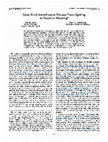
Journal of Experimental Psychology-general, 1991
Six experiments addressed the role of phonological information in visual word recognition using a... more Six experiments addressed the role of phonological information in visual word recognition using a semantic-decision task. Experiment 1 replicated finding that Ss make more false-positive errors on homophone foils than on spelling controls, indicating phonological activation of meaning. Experiment 2 showed that only lower frequency words yield this effect when broader categories are used. In Experiments 3 and 4, the homophony effect for lower frequency words remained, even though the stimuli included a large proportion of homophones, suggesting that activation of phonological information cannot be strategically inhibited. Experiments 5 and 6 examined effects of homophony on targets that were correct category exemplars and yielded similar results. These studies indicate that in skilled readers, phonological information contributes to the activation of word meaning only for low-frequency words.
Journal of Experimental Child Psychology, 1997
Scientific Studies of Reading, 1999
... See Dick RAN: Rapid Naming and the Longitudinal Prediction of Reading Subskills in First and ... more ... See Dick RAN: Rapid Naming and the Longitudinal Prediction of Reading Subskills in First and Second Graders ... Page 3. RAPID NAMING AND READING 131 ...
Brain and language, 2013
We employed brain-behavior analyses to explore the relationship between performance on tasks meas... more We employed brain-behavior analyses to explore the relationship between performance on tasks measuring phonological awareness, pseudoword decoding, and rapid auditory processing (all predictors of reading (dis)ability) and brain organization for print and speech in beginning readers. For print-related activation, we observed a shared set of skill-correlated regions, including left hemisphere temporoparietal and occipitotemporal sites, as well as inferior frontal, visual, visual attention, and subcortical components. For speech-related activation, shared variance among reading skill measures was most prominently correlated with activation in left hemisphere inferior frontal gyrus and precuneus. Implications for brain-based models of literacy acquisition are discussed.
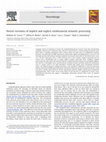
Neuroimage, 2010
Language consists of sequences of words, but comprehending phrases involves more than concatenati... more Language consists of sequences of words, but comprehending phrases involves more than concatenating meanings: A boat house is a shelter for boats, whereas a summer house is a house used during summer, and a ghost house is typically uninhabited. Little is known about the brain bases of combinatorial semantic processes. We performed two fMRI experiments using familiar, highly meaningful phrases (LAKE HOUSE) and unfamiliar phrases with minimal meaning created by reversing the word order of the familiar items (HOUSE LAKE). The first experiment used a 1-back matching task to assess implicit semantic processing, and the second used a classification task to engage explicit semantic processing. These conditions required processing of the same words, but with more effective combinatorial processing in the meaningful condition. The contrast of meaningful versus reversed phrases revealed activation primarily during the classification task, to a greater extent in the right hemisphere, including right angular gyrus, dorsomedial prefrontal cortex, and bilateral posterior cingulate/precuneus, areas previously implicated in semantic processing. Positive correlations of fMRI signal with lexical (word-level) frequency occurred exclusively with the 1-back task and to a greater spatial extent on the left, including left posterior middle temporal gyrus and bilateral parahippocampus. These results reveal strong effects of task demands on engagement of lexical versus combinatorial processing and suggest a hemispheric dissociation between these levels of semantic representation.

Journal of Cognitive Neuroscience, 2011
The role of sensory-motor systems in conceptual understanding has been controversial. It has been... more The role of sensory-motor systems in conceptual understanding has been controversial. It has been proposed that many abstract concepts are understood metaphorically through concrete sensory-motor domains such as actions. Using fMRI, we compared neural responses with literal action (Lit; The daughter grasped the flowers), metaphoric action (Met; The public grasped the idea), and abstract (Abs; The public understood the idea) sentences of varying familiarity. Both Lit and Met sentences activated the left anterior inferior parietal lobule, an area involved in action planning, with Met sentences also activating a homologous area in the right hemisphere, relative to Abs sentences. Both Met and Abs sentences activated the left superior temporal regions associated with abstract language. Importantly, activation in primary motor and biological motion perception regions was inversely correlated with Lit and Met familiarity. These results support the view that the understanding of metaphoric action retains a link to sensory-motor systems involved in action performance. However, the involvement of sensory-motor systems in metaphor understanding changes through a gradual abstraction process whereby relatively detailed simulations are used for understanding unfamiliar metaphors, and these simulations become less detailed and involve only secondary motor regions as familiarity increases. Consistent with these data, we propose that anterior inferior parietal lobule serves as an interface between sensory-motor and conceptual systems and plays an important role in both domains. The similarity of abstract and metaphoric sentences in the activation of left superior temporal regions suggests that action metaphor understanding is not completely based on sensory-motor simulations but relies also on abstract lexical-semantic codes.
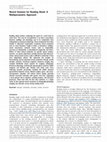
Cerebral Cortex, 2009
Reading aloud involves computing the sound of a word from its visual form. This may be accomplish... more Reading aloud involves computing the sound of a word from its visual form. This may be accomplished 1) by direct associations between spellings and phonology and 2) by computation from orthography to meaning to phonology. These components have been studied in behavioral experiments examining lexical properties such as word frequency; length in letters or phonemes; spelling-sound consistency; semantic factors such as imageability, measures of orthographic, or phonological complexity; and others. Effects of these lexical properties on specific neural systems, however, are poorly understood, partially because high intercorrelations among lexical factors make it difficult to determine if they have independent effects. We addressed this problem by decorrelating several important lexical properties through careful stimulus selection. Functional magnetic resonance imaging data revealed distributed neural systems for mapping orthography directly to phonology, involving left supramarginal, posterior middle temporal, and fusiform gyri. Distinct from these were areas reflecting semantic processing, including left middle temporal gyrus/inferior-temporal sulcus, bilateral angular gyrus, and precuneus/posterior cingulate. Left inferior frontal regions generally showed increased activation with greater task load, suggesting a more general role in attention, working memory, and executive processes. These data offer the first clear evidence, in a single study, for the separate neural correlates of orthography--phonology mapping and semantic access during reading aloud.
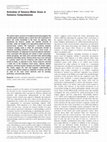
Cerebral Cortex, 2010
The sensory--motor account of conceptual processing suggests that modality-specific attributes pl... more The sensory--motor account of conceptual processing suggests that modality-specific attributes play a central role in the organization of object and action knowledge in the brain. An opposing view emphasizes the abstract, amodal, and symbolic character of concepts, which are thought to be represented outside the brain's sensory--motor systems. We conducted a functional magnetic resonance imaging study in which the participants listened to sentences describing hand/arm action events, visual events, or abstract behaviors. In comparison to visual and abstract sentences, areas associated with planning and control of hand movements, motion perception, and vision were activated when understanding sentences describing actions. Sensory--motor areas were activated to a greater extent also for sentences with actions that relied mostly on hands, as opposed to arms. Visual sentences activated a small area in the secondary visual cortex, whereas abstract sentences activated superior temporal and inferior frontal regions. The results support the view that linguistic understanding of actions partly involves imagery or simulation of actions, and relies on some of the same neural substrate used for planning, performing, and perceiving actions.

Proceedings of The National Academy of Sciences, 1999
The formation of the past tense of verbs in English has been the focus of the debate concerning c... more The formation of the past tense of verbs in English has been the focus of the debate concerning connectionist vs. symbolic accounts of language. Brain-injured patients differ with respect to whether they are more impaired in generating irregular past tenses (TAKE-TOOK) or past tenses for nonce verbs (WUG-WUGGED). Such dissociations have been taken as evidence for distinct "rule" and "associative" memory systems in morphology and against the connectionist approach in which a single system is used for all forms. We describe a simulation model in which these impairments arise from damage to phonological or semantic information, which have different effects on generalization and irregular forms, respectively. The results provide an account of the bases of impairments in verb morphology and show that these impairments can be explained within connectionist models that do not use rules or a separate mechanism for exceptions.

Brain and Language, 2003
Difficulties in resolving pronominal anaphora have been taken as evidence that Specific Language ... more Difficulties in resolving pronominal anaphora have been taken as evidence that Specific Language Impairment (SLI) involves a grammar-specific impairment. The present study explores an alternative view, that grammatical deficits in SLI are sequelae of impaired speech perception. This perceptual deficit specifically affects the use of phonological information in working memory, which in turn leads to poorer than expected syntactic comprehension. This hypothesis was explored using a connectionist model of sentence processing that learned to map sequences of words to their meanings. Anaphoric resolution was represented in this model by recognizing the semantics of the correct antecedent when a bound pronoun was input. When the model was trained on distorted phonological inputs-simulating a perceptual deficit-it exhibited marked difficulty resolving bound anaphors. However, many other aspects of sentence comprehension were intact; most importantly, the model could still resolve pronouns using gender information. In addition, the modelÕs deficit was graded rather than categorical, as it was able to resolve pronouns in some sentences, but not in others. These results are consistent with behavioral data concerning syntactic deficits in SLI. The model provides a causal demonstration of how a perceptual deficit could give rise to grammatical deficits in SLI. Ó 2003 Published by Elsevier Science (USA). Brain and Language xxx (2003) xxx-xxx www.elsevier.com/locate/b&l q

Journal of Experimental Child Psychology, 2000
We investigated the relationship between dyslexia and three aspects of language: speech perceptio... more We investigated the relationship between dyslexia and three aspects of language: speech perception, phonology, and morphology. Reading and language tasks were administered to dyslexics aged 8 -9 years and to two normal reader groups (age-matched and reading-level matched). Three dyslexic groups were identified: phonological dyslexics (PD), developmentally language impaired (LI), and globally delayed (delay-type dyslexics). The LI and PD groups exhibited similar patterns of reading impairment, attributed to low phonological skills. However, only the LI group showed clear speech perception deficits, suggesting that such deficits affect only a subset of dyslexics. Results also indicated phonological impairments in children whose speech perception was normal. Both the LI and the PD groups showed inflectional morphology difficulties, with the impairment being more severe in the LI group. The delay group's reading and language skills closely matched those of younger normal readers, suggesting these children had a general delay in reading and language skills, rather than a specific phonological impairment. The results are discussed in terms of models of word recognition and dyslexia.
Trends in Cognitive Sciences, 1998
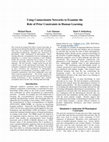
This research investigated the effects of prior knowledge on learning in psychologically-plausibl... more This research investigated the effects of prior knowledge on learning in psychologically-plausible connectionist networks. This issue was examined with respect to the benchmark orthography-to-phonology mapping task (Sejnowski & Rosenberg, 1986; Seidenberg & McClelland, 1989). Learning about the correspondences between orthography and phonology is a critical step in learning to read. Children (unlike the networks mentioned above) bring to this task extensive knowledge about the sound-structure of their language. We first describe a simple neural network that acquired some of this phonological knowledge. We then summarize simulations showing that having this knowledge in place facilitates the acquisition of orthographicphonological correspondences, producing a higher level of asymptotic performance with fewer implausible errors and better nonword generalization. The results suggest that connectionist networks may provide closer approximations to human performance if they incorporate more realistic assumptions about relevant sorts of background knowledge.
Scientific Studies of Reading, 2003
A connectionist model of reading development previously used to simulate detailed aspects of deve... more A connectionist model of reading development previously used to simulate detailed aspects of developmental dyslexia (Harm & Seidenberg, 1999) was applied to explore why certain classes of interventions designed to overcome reading impairments are more effective than others. Previous research has shown that interventions targeting the development of spelling-sound correspondences are more effective at improving generalizability skills than ones designed solely to increase phonological awareness. The simulations broadly replicate the patterns of success and failure found in the developmental literature, and provide explicit computational insights into exactly why the interventions that include training on spelling-sound regularities are more effective than those targeting phonological development alone.







Uploads
Papers by Mark Seidenberg